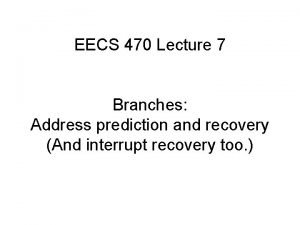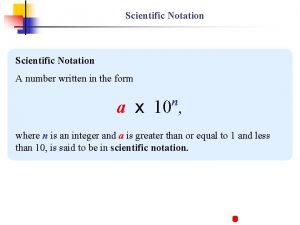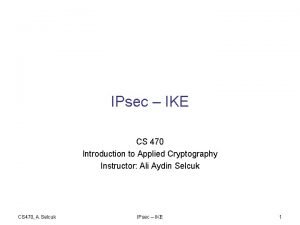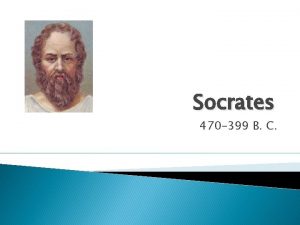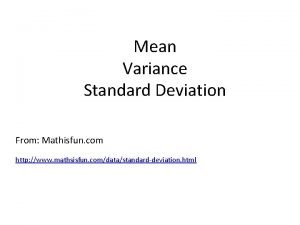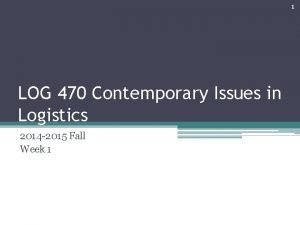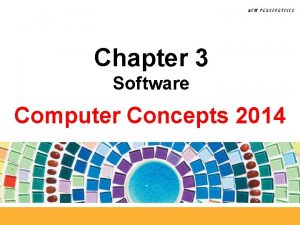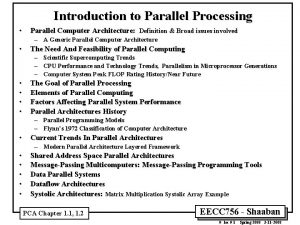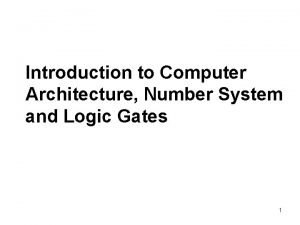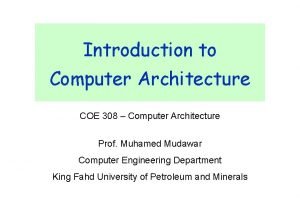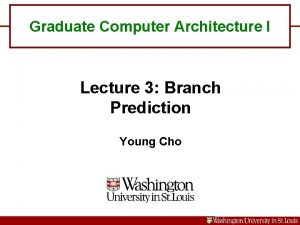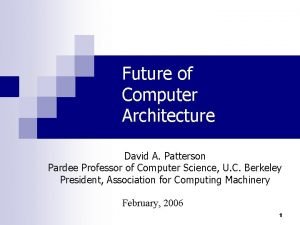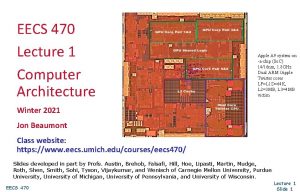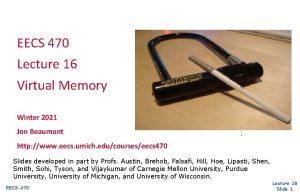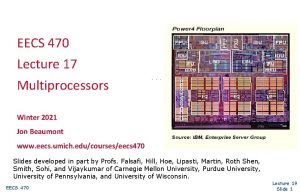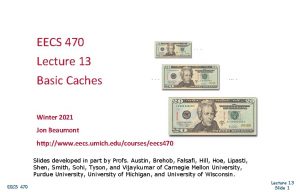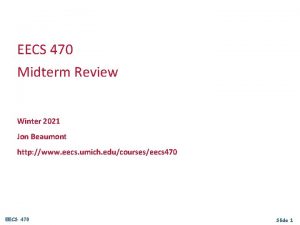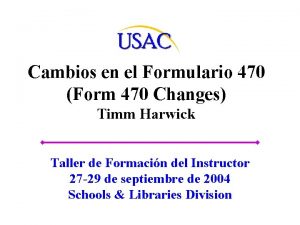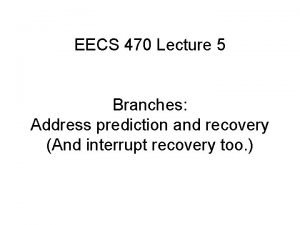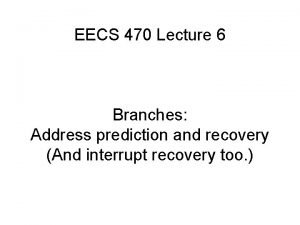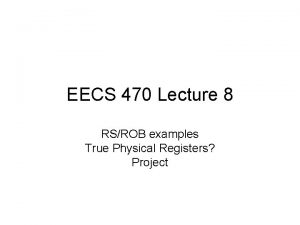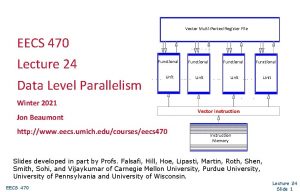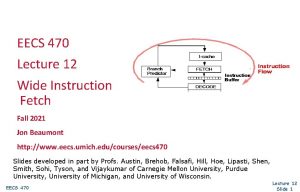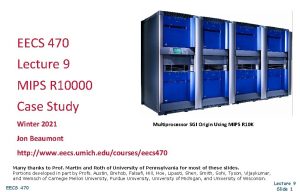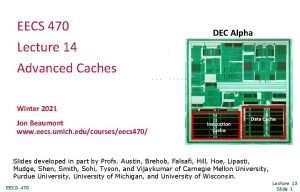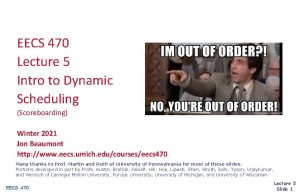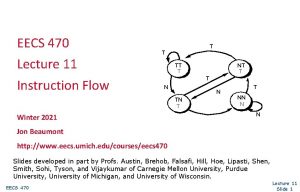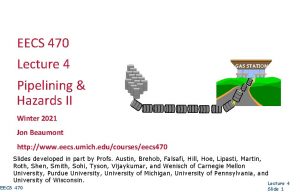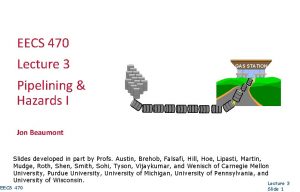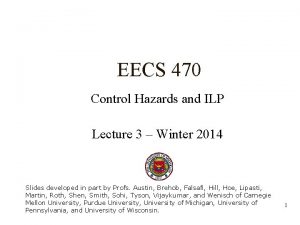EECS 470 Lecture 1 Computer Architecture Winter 2014
























































- Slides: 56

EECS 470 Lecture 1 Computer Architecture Winter 2014 Slides developed in part by Profs. Brehob, Austin, Falsafi, Hill, Hoe, Lipasti, Shen, Smith, Sohi, Tyson, Vijaykumar, and Wenisch 1

What Is Computer Architecture? “The term architecture is used here to describe the attributes of a system as seen by the programmer, i. e. , the conceptual structure and functional behavior as distinct from the organization of the dataflow and controls, the logic design, and the physical implementation. ” Gene Amdahl, IBM Journal of R&D, April 1964

Architecture as used here… • We use a wider definition – The stuff seen by the programmer • Instructions, registers, programming model, etc. – Micro-architecture • How the architecture is implemented.

Intro Teaching Staff Instructor GSIs/IA • Dr. Mark Brehob, brehob • Jonathan Beaumont, jbbeau • William Cunningham, wcunning – Office hours: (4632 Beyster unless noted) • Monday 10 am-noon • Tuesday 3: 30 pm-5: 00 – EECS 2334, which is the 373 lab--you'll need to grab me and let me know you have an EECS 470 question. • Thursday 10: 30 am-noon • I’ll also be around after class for 10 -15 minutes most days. • This Thursday (only) my hours will be 9 am-10. – – – – Monday-- 5: 00 pm-6: 30 (Will) Tuesday-- 5: 00 pm-6: 30 (Jon) Wednesday-- 5: 00 pm-6: 30 (Will) Thursday-- 5: 00 pm-6: 30 (Jon) Friday-- 12: 30 pm-2: 00 (varies) Friday-- 4: 00 pm-5: 00 (both) Saturday-- 2: 00 pm-5: 00 (Jon) Sunday-- 6: 00 pm-9: 00 (Will)

Outline Lecture Today • Class intro (30 minutes) – Class goals – Your grade – Work expected • Start review – Fundamental concepts – Pipelines – Hazards and Dependencies (time allowing) – Performance measurement (as reference only)

Class goals • Provide a high-level understanding of many of the relevant issues in modern computer architecture – – – Dynamic Out-of-order processing Static (complier based) out-of-order processing Memory hierarchy issues and improvements Multi-processor issues Power and reliability issues • Provide a low-level understanding of the most important parts of modern computer architecture. – Details about all the functions a given component will need to perform – How difficult certain tasks, such as caching, really are in hardware

Communication • Website: http: //www. eecs. umich. edu/courses/eecs 470/ • Piazza – You should be able to get on via ctools. • We won’t be using ctools otherwise for the most part. • Email – eecs 470 w 14 staff@umich. edu. We very much prefer you use Piazza. • Lab – Attend your assigned section—very full (may need to double up some? ) – You need to go!

Class goals Course outline – near term

Your grade Grading • Grade weights are: – Midterm – 24% – Final Exam – 24% – Homework/Quiz – 9% • 6 homeworks, 1 quiz, all equal. Drop the lowest grade. – Verilog Programming assignments – 7% • 3 assignments worth 2%, and 3% – In lab assignments – 1% – Project – 35% • Open-ended (group) processor design in Verilog • Grades can vary quite a bit, so is a distinguisher.

Work expected Hours (and hours) of work • Attend class & discussion – You really need to go to lab! – 5 hours/week • Read book & handouts – 2 -3 hours/week • Do homework – 5 assignments at ~4 hours each/15 weeks – 1 -2 hours/week • 3 Programming assignments – 6, 6, 20 hours each = 32 hours/15 weeks – ~2 hours/week • Verilog Project – ~200 hours/15 weeks = 13 hours/week • General studying – ~ 1 hour/week • Total: – ~25 hours/week, some students claim more. . .

“Key” concepts

Amdahl’s Law Speedup= timewithout enhancement / timewith enhancement Suppose an enhancement speeds up a fraction f of a task by a factor of S timenew = timeorig·( (1 -f) + f/S ) Soverall = 1 / ( (1 -f) + f/S ) timeorig time orig (1 - f)1 f f timenew (1 - f) (1 f/S- f) f/S

Parallelism: Work and Critical Path Parallelism - the amount of independent sub-tasks available Work=T 1 - time to complete a computation on a sequential system Critical Path=T - time to complete the same computation on an infinitelyparallel system Average Parallelism Pavg = T 1 / T For a p wide system Tp max{ T 1/p, T } Pavg>>p T 1/p x = a + b; y = b * 2 z =(x-y) * (x+y)

Locality Principle One’s recent past is a good indication of near future. – Temporal Locality: If you looked something up, it is very likely that you will look it up again soon – Spatial Locality: If you looked something up, it is very likely you will look up something nearby next Locality == Patterns == Predictability Converse: Anti-locality : If you haven’t done something for a very long time, it is very likely you won’t do it in the near future either

Memoization Dual of temporal locality but for computation If something is expensive to compute, you might want to remember the answer for a while, just in case you will need the same answer again Why does memoization work? ? Examples – Trace caches

Amortization overhead cost : one-time cost to set something up per-unit cost : cost for per unit of operation total cost = overhead + per-unit cost x N It is often okay to have a high overhead cost if the cost can be distributed over a large number of units lower the average cost = total cost / N = ( overhead / N ) + per-unit cost

Trends in computer architecture

A Paradigm Shift In Computing Transistors (100, 000's) 100000 Power (W) Performance (GOPS) 10000 Efficiency (GOPS/W) 1000 IEEE Computer—April 2001 T. Mudge 100 10 Limits on heat extraction 1 Stagnates performance growth 0, 1 0, 01 Limits on energy-efficiency of operations 0, 001 1985 1995 2005 Era of High Performance Computing 2015 c. 2000 Era of Energy-Efficient Computing 18

The Memory Wall Processor Memory Source: Hennessy & Patterson, Computer Architecture: A Quantitative Approach, 4 th ed. Today: 1 mem access 500 arithmetic ops

Reliability Wall Transient faults – E. g, high-energy particle strikes transients Manufacturing faults – E. g. , broken connections Wearout faults – E. g. , Electromigration Device variability (not all transistors created equal) burn-in interconnect via

Review of basic pipelining

Pipeline review Review of basic pipelining • 5 stage “RISC” load-store architecture – About as simple as things get 1. Instruction fetch: • get instruction from memory/cache 2. Instruction decode: • translate opcode into control signals and read regs 3. Execute: • perform ALU operation 4. Memory: • Access memory if load/store 5. Writeback/retire: • update register file

Pipelined implementation • Break the execution of the instruction into cycles (5 in this case). • Design a separate datapath stage for the execution performed during each cycle. • Build pipeline registers to communicate between the stages.

Stage 1: Fetch • Design a datapath that can fetch an instruction from memory every cycle. – Use PC to index memory to read instruction – Increment the PC (assume no branches for now) • Write everything needed to complete execution to the pipeline register (IF/ID) – The next stage will read this pipeline register. – Note that pipeline register must be edge triggered

PC Instruction Memory/ Cache en en IF / ID Pipeline register Rest of pipelined datapath + Instruction bits 1 PC + 1 M U X

Stage 2: Decode • Design a datapath that reads the IF/ID pipeline register, decodes instruction and reads register file (specified by reg. A and reg. B of instruction bits). – Decode can be easy, just pass on the opcode and let later stages figure out their own control signals for the instruction. • Write everything needed to complete execution to the pipeline register (ID/EX) – Pass on the offset field and both destination register specifiers (or simply pass on the whole instruction!). – Including PC+1 even though decode didn’t use it.

Instruction bits Destreg Data en Contents Of reg. A PC + 1 Rest of pipelined datapath Contents Of reg. B Register File Control Signals PC + 1 Stage 1: Fetch datapath reg. A reg. B IF / ID ID / EX Pipeline register

Stage 3: Execute • Design a datapath that performs the proper ALU operation for the instruction specified and the values present in the ID/EX pipeline register. – The inputs are the contents of reg. A and either the contents of Reg. B or the offset field on the instruction. – Also, calculate PC+1+offset in case this is a branch. • Write everything needed to complete execution to the pipeline register (EX/Mem) – ALU result, contents of reg. B and PC+1+offset – Instruction bits for opcode and dest. Reg specifiers

Control Signals Contents Of reg. B M U X contents of reg. B Contents Of reg. A Alu Result A L U ID / EX EX/Mem Pipeline register PC + 1 PC+1 +offset Rest of pipelined datapath Control Signals Stage 2: Decode datapath +

Stage 4: Memory Operation • Design a datapath that performs the proper memory operation for the instruction specified and the values present in the EX/Mem pipeline register. – ALU result contains address for ld and st instructions. – Opcode bits control memory R/W and enable signals. • Write everything needed to complete execution to the pipeline register (Mem/WB) – ALU result and Mem. Data – Instruction bits for opcode and dest. Reg specifiers

Control Signals contents of reg. B Data Memory Read Data Alu Result PC+1 +offset MUX control for PC input en R/W EX/Mem Mem/WB Pipeline register Rest of pipelined datapath Control Signals Stage 3: Execute datapath This goes back to the MUX before the PC in stage 1.

Stage 5: Write back • Design a datapath that conpletes the execution of this instruction, writing to the register file if required. – Write Mem. Data to dest. Reg for ld instruction – Write ALU result to dest. Reg for add or nand instructions. – Opcode bits also control register write enable signal.

Memory Read Data Alu Result M U X Control Signals Stage 4: Memory datapath This goes back to data input of register file Mem/WB Pipeline register bits 0 -2 This goes back to the destination register specifier register write enable M U X bits 16 -18

What can go wrong? • Data hazards: since register reads occur in stage 2 and register writes occur in stage 5 it is possible to read the wrong value if is about to be written. • Control hazards: A branch instruction may change the PC, but not until stage 4. What do we fetch before that? • Exceptions: How do you handle exceptions in a pipelined processor with 5 instructions in flight?

Basic Pipelining Fetch Decode Execute Memory WB M U X 1 + PC+1 R 0 R 2 Register file Inst mem target 0 eq? R 1 reg. A reg. B instruction PC + R 3 val. A R 4 R 5 R 6 val. B R 7 offset M U X A L U ALU result mdata Data memory data dest val. B Bits 0 -2 Bits 16 -18 Bits 22 -24 IF/ ID M U X dest op op op ID/ EX EX/ Mem M U X Mem/ 35 WB

Basic Pipelining Fetch Decode Execute Memory WB M U X 1 + PC+1 R 0 M U X target 0 eq? R 1 reg. A reg. B R 2 Register file Inst mem instruction PC + R 3 val. A R 4 R 5 R 6 val. B R 7 offset M U X A L U ALU result mdata Data memory data dest val. B IF/ ID dest op op op ID/ EX EX/ Mem M U X Mem/ 36 WB

Basic Pipelining Fetch Decode Execute Memory WB M U X 1 + PC+1 R 0 M U X data target 0 eq? R 1 reg. A reg. B R 2 Register file Inst mem instruction PC + R 3 val. A R 4 R 5 R 6 val. B R 7 offset M U X A L U ALU result mdata Data memory val. B IF/ ID op op op fwd fwd ID/ EX EX/ Mem/ 37 WB M U X

Measuring performance This will not be covered in class but you need to read it. EECS 470 Lecture 1 Slide 38

Metrics of Performance Time (latency) r elapsed time vs. processor time Rate (bandwidth or throughput) r performance = rate = work per time Distinction is sometimes blurred r r r consider batched vs. interactive processing consider overlapped vs. non-overlapped processing may require conflicting optimizations What is the most popular metric of performance? EECS 470 Lecture 1 Slide 39

The “Iron Law” of Processor Performance EECS 470 Lecture 1 Slide 40

MIPS - Millions of Instructions per Second instructions MIPS #=ofbenchmark X benchmark total run time 1, 000 When comparing two machines (A, B) with the same instruction set, MIPS is a fair comparison (sometimes…) But, MIPS can be a “meaningless indicator of performance…” • instruction sets are not equivalent • different programs use a different instruction mix • instruction count is not a reliable indicator of work EECS 470 r some optimizations add instructions Lecture 1 Slide 41

MIPS (Cont. ) Example: r Machine A has a special instruction for performing square root m It takes 100 cycles to execute r Machine B doesn’t have the special instruction m must perform square root in software using simple instructions m e. g, Add, Mult, Shift each take 1 cycle to execute r r Machine A: 1/100 MIPS = 0. 01 MIPS Machine B: 1 MIPS EECS 470 Lecture 1 Slide 42

MFLOPS = (FP ops/program) x (program/time) x 10 -6 Popular in scientific computing There was a time when FP ops were much slower than regular instructions (i. e. , off -chip, sequential execution) r Not great for “predicting” performance because it r r r EECS 470 ignores other instructions (e. g. , load/store) not all FP ops are created equally depends on how FP-intensive program is Lecture 1 Slide 43

Comparing Performance Often, we want to compare the performance of different machines or different programs. Why? r help architects understand which is “better” r give marketing a “silver bullet” for the press release r help customers understand why they should buy <my machine> EECS 470 Lecture 1 Slide 44

Performance vs. Execution Time Often, we use the phrase “X is faster than Y” Means the response time or execution time is lower on X than on Y r Mathematically, “X is N times faster than Y” means r Execution Time. Y Execution Time. X Execution Time. Y Performance. X Execution Time. X Performance. Y = = N N = 1/Performance. Y 1/Performance. X Performance and Execution time are reciprocals EECS 470 = Lecture 1 Slide 45

By Definition Machine A is n times faster than machine B iff perf(A)/perf(B) = time(B)/time(A) = n Machine A is x% faster than machine B iff perf(A)/perf(B) = time(B)/time(A) = 1 + x/100 E. g. , A 10 s, B 15 s 15/10 = 1. 5 A is 1. 5 times faster than B 15/10 = 1 + 50/100 A is 50% faster than B EECS 470 Lecture 1 Slide 46

Let’s Try a Simpler Example Two machines timed on two benchmarks Machine A Program 1 seconds Program 2 seconds 12 seconds Machine B 4 8 How much faster is Machine A than Machine B? r Attempt 1: ratio of run times, normalized to Machine A times r program 1: 4/2 r EECS 470 program 2 : 8/12 Machine A ran 2 times faster on program 1, 2/3 times faster on program 2 Lecture 1 Slide 47

Example (con’t) Two machines timed on two benchmarks Program 1 Program 2 Machine A 2 seconds 12 seconds 8 seconds Machine B 4 seconds How much faster is Machine A than B? r Attempt 2: ratio of run times, normalized to Machine B times r program 1: 2/4 program 2 : 12/8 Machine A ran program 1 in 1/2 the time and program 2 in 3/2 the time r On average, (1/2 + 3/2) / 2 = 1 r Put another way, Machine A is 1. 0 times faster than Lecture 1 EECS 470 Slide 48 Machine B r

Example (con’t) Two machines timed on two benchmarks Program 1 Program 2 Machine A 2 seconds 12 seconds 8 seconds Machine B 4 seconds How much faster is Machine A than B? r Attempt 3: ratio of run times, aggregate (total sum) times, norm. to A r m Machine A took 14 seconds for both programs m Machine B took 12 seconds for both programs m Therefore, Machine A takes 14/12 of the time of Machine B m Put another way, Machine A is 6/7 faster than Machine B EECS 470 Lecture 1 Slide 49

Which is Right? Question: r How can we get three different answers? Solution r Because, while they are all reasonable calculations… …each answers a different question We need to be more precise in understanding and posing these performance & metric questions EECS 470 Lecture 1 Slide 50

Arithmetic and Harmonic Mean Average of the execution time that tracks total execution time is the arithmetic mean This is the defn for “average” you are most familiar with If performance is expressed as a rate, then the average that tracks total execution time is the harmonic mean This is a different defn for “average” you are prob. less familiar with EECS 470 Lecture 1 Slide 51

Quiz E. g. , 30 mph for first 10 miles, 90 mph for next 10 miles What is the average speed? Average speed = (30 + 90)/2 = 60 mph (Wrong!) The correct answer: Average speed = total distance / total time = 20 / (10/30 + 10/90) = 45 mph For rates use Harmonic Mean! EECS 470 Lecture 1 Slide 52

Problems with Arithmetic Mean Applications do not have the same probability of being run Longer programs weigh more heavily in the average For example, two machines timed on two benchmarks Machine A Machine B Program 1 2 seconds (20%) Program 2 12 seconds (80%) m EECS 470 4 8 If we do arithmetic mean, Program 2 “counts more” than Program 1 q an improvement in Program 2 changes the average more than a proportional improvement in Program 1 Lecture 1 Slide 53

Weighted Execution Time Often, one runs some programs more often than others. Therefore, we should weight the more frequently used programs’ execution time Weighted Harmonic Mean EECS 470 Lecture 1 Slide 54

Using a Weighted Sum (or weighted average) Machine A Program 1 2 seconds (20%) Program 2 12 seconds (80%) Total 10 seconds Machine B 4 8 7. 2 seconds m Allows us to determine relative performance 10/7. 2 = 1. 38 --> Machine B is 1. 38 times faster than Machine A EECS 470 Lecture 1 Slide 55

Summary Performance is important to measure For architects comparing different deep mechanisms r For developers of software trying to optimize code, applications r For users, trying to decide which machine to use, or to buy r Performance metrics are subtle Easy to mess up the “machine A is XXX times faster than machine B” numerical performance comparison r You need to know exactly what you are measuring: time, rate, throughput, CPI, cycles, etc r You need to know how combining these to give aggregate numbers does different kinds of “distortions” to the individual numbers r No metric is perfect, so lots of emphasis on standard Lecture 1 EECS 470 r Slide 56
 Eecs 470
Eecs 470 Eecs470
Eecs470 Data hazard pipeline
Data hazard pipeline Computer architecture lecture notes
Computer architecture lecture notes Microarchitecture vs isa
Microarchitecture vs isa Winter kommt winter kommt flocken fallen nieder
Winter kommt winter kommt flocken fallen nieder Winter kommt winter kommt flocken fallen nieder lied
Winter kommt winter kommt flocken fallen nieder lied Es ist kalt es ist kalt flocken fallen nieder
Es ist kalt es ist kalt flocken fallen nieder 01:640:244 lecture notes - lecture 15: plat, idah, farad
01:640:244 lecture notes - lecture 15: plat, idah, farad Bus design in computer architecture
Bus design in computer architecture 470 クラスルール
470 クラスルール 470 in scientific notation
470 in scientific notation Cs 470
Cs 470 Cs 470
Cs 470 Davies meyer construction
Davies meyer construction Sfu cmpt 470
Sfu cmpt 470 470 399
470 399 Standard normal distribution math is fun
Standard normal distribution math is fun 470 12
470 12 470/12
470/12 Contemporary issues in logistics
Contemporary issues in logistics Computer architecture and organisation
Computer architecture and organisation Basic computer organization and design
Basic computer organization and design Computer concepts 2014
Computer concepts 2014 Computer security 161 cryptocurrency lecture
Computer security 161 cryptocurrency lecture Computer-aided drug design lecture notes
Computer-aided drug design lecture notes The architecture business cycle
The architecture business cycle Return architecture
Return architecture Modular vs integral product architecture example
Modular vs integral product architecture example Fundamental and incidental interactions
Fundamental and incidental interactions Computer organization and architecture 10th solution
Computer organization and architecture 10th solution Computer architecture 101
Computer architecture 101 Iit kharagpur virtual lab computer organization
Iit kharagpur virtual lab computer organization Introduction to computer organization and architecture
Introduction to computer organization and architecture Timing and control in computer architecture
Timing and control in computer architecture Evolution of computer architecture
Evolution of computer architecture Dma controller in computer architecture
Dma controller in computer architecture Fp adder
Fp adder Absolute addressing mode in computer architecture
Absolute addressing mode in computer architecture Static interconnection network in computer architecture
Static interconnection network in computer architecture Smt computer architecture
Smt computer architecture Pseudoinstructions
Pseudoinstructions Collision prevention in computer architecture
Collision prevention in computer architecture Instruction format in computer architecture
Instruction format in computer architecture Nano programming
Nano programming Fetch routine
Fetch routine Memory system design in computer architecture
Memory system design in computer architecture Memory hierarchy
Memory hierarchy Linear pipeline vs non linear pipeline
Linear pipeline vs non linear pipeline Computer architecture definition
Computer architecture definition Define parallelism in computer architecture
Define parallelism in computer architecture Number system in computer architecture
Number system in computer architecture What is computer architecture
What is computer architecture Isa meaning computer
Isa meaning computer Input and output devices chart
Input and output devices chart Branch prediction in computer architecture
Branch prediction in computer architecture Computer architecture david patterson
Computer architecture david patterson
